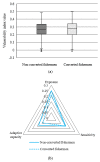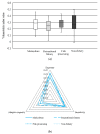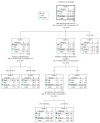Livelihood Vulnerability of Marine Fishermen to Multi-Stresses under the Vessel Buyback and Fishermen Transfer Programs in China: The Case of Zhoushan City, Zhejiang Province
- PMID: 31991750
- PMCID: PMC7037923
- DOI: 10.3390/ijerph17030765
Livelihood Vulnerability of Marine Fishermen to Multi-Stresses under the Vessel Buyback and Fishermen Transfer Programs in China: The Case of Zhoushan City, Zhejiang Province
Abstract
In the context of vessel buyback and fishermen transfer, some traditional marine fishermen changed their profession and turned to other related industries such as mariculture, fish processing, and recreational fishery. Studying the livelihood vulnerability of different types of fishermen is an important basis to help fishermen rebuild sustainable livelihoods. This paper developed a framework of a fishermen's livelihood vulnerability assessment under multi-stresses, and then conducted an empirical analysis based on a survey in Zhoushan City, Zhejiang Province, China. Finally, the determinants of livelihood vulnerability were analyzed by a regression tree model. Results showed that fishermen with a high level of vulnerability accounted for about 37.35%, and they had some unique characteristics such as advanced age, low education levels. Although converted fishermen faced fewer exposure risks than non-converted fishermen, they eventually showed higher vulnerability due to poor adaptive ability. The livelihood vulnerability of fishermen engaged in recreational fisheries was relatively low, while that of fishermen engaged in non-fisheries was quite different from each other. The results of the regression tree analysis showed that the number of household income sources, whether they converted or not, impacts of disturbances, and whether they were equipped with fishery facilities could influence the fishermen's livelihood vulnerability. The government should pay more attention to the fishermen whose family income source was single, and the converted fishermen whose productive physical capital was scare.
Keywords: livelihood assets; livelihood vulnerability; marine fishermen; vessel buyback and fishermen transfer programs.
Conflict of interest statement
The authors declare no conflict of interest.
Figures





References
-
- Pauly D. Small-Scale Fisheries in the Tropics: Marginality, Marginalisation, and Some Implications for Fisheries Management. In: Pikitch E.K., Huppert D.D., Sissenwine M.P., editors. Global Trends: Fisheries Management. American Fisheries Society; Bethesda, MD, USA: 1997. pp. 40–49.
-
- Han L.M. Research on the “Blue Granary” Strategy in the Development of China’s Marine Industry. Economic Science Press; Beijing, China: 2018. (In Chinese)
-
- Food and Agriculture Organization of the United Nations . Review of the State of World Marine Fishery Resources. FAO; Rome, Italy: 2011. FAO Fisheries and Aquaculture Technical Paper No. 569.
-
- Nayak P.K. Fisher communities in transition: Understanding change from a livelihood perspective in Chilika Lagoon, India. Marit. Stud. 2017;16:13. doi: 10.1186/s40152-017-0067-3. - DOI
MeSH terms
LinkOut - more resources
Full Text Sources
Medical

